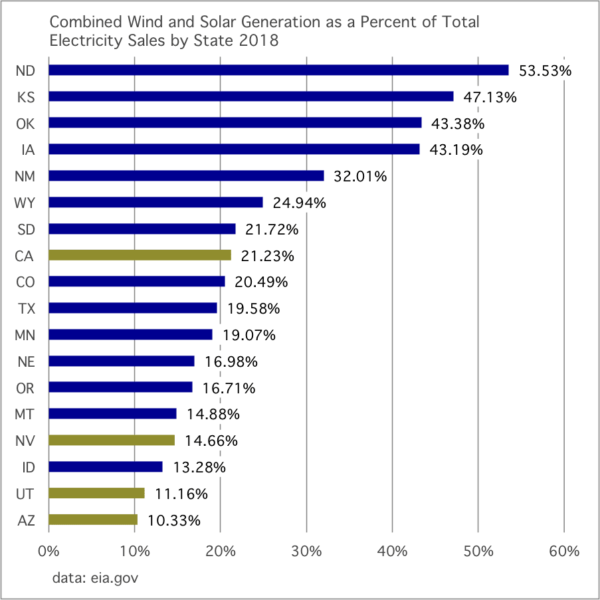From pv magazine USA.
If any further evidence were needed that the headline grabbing Green New Deal policy package – targeting full decarbonization of U.S. electricity – will be accomplished at state before federal level, New Mexico has supplied it.
On Tuesday, the New Mexico House passed SB 489 (bill text) mandating the state move to 100% zero carbon electricity by 2045, the same target as set in California. The 43-22 vote in the House came after the Energy Transition Act passed the New Mexico Senate on March 6.
The bill will go to New Mexico governor Michelle Grisham (Democrat), who is expected to sign it after campaigning on a pledge to move the state to 80% renewable energy by 2040.
Renewable or zero-carbon?
Like California’s zero-carbon standard, the Energy Transition Act in New Mexico is really two mandates: one for zero-carbon electricity and a second for renewable electricity. While both pieces of legislation have a 2045 timeline for zero-carbon electricity, they set slightly different standards for renewables.

California has a 60% by 2030 renewable portfolio standard but New Mexico opted for 50% by that date. However, SB 489 also sets a mandate that utilities in the state source 80% of their electricity from renewables by 2040, as per governor Grisham’s pledge.
While 50% by 2030 would be ambitious for many states, though, it is not much of a stretch for New Mexico. Wind and solar generation already amounted to 32% of the state’s electricity sales last year – the fifth-highest proportion nationally – according to analysis by energy writer Gregor Macdonald, who used U.S. Department of Energy data.
Hydro and nuclear
New Mexico has limitations on big hydro in the renewable energy portion of the pending mandate under the Energy Transition Act. Similarly, California’s policies do not include large hydro plants in their definition of renewable energy.
The only other zero carbon resource deployed at scale is nuclear power; California has one nuclear power plant left, which is scheduled to retire in 2025. New Mexico has none. However, utility El Paso Electric – which has service areas in Texas and New Mexico – has contracts to buy power from a portion of the 4 GW Palo Verde nuclear plant in Arizona, the largest nuclear facility in the U.S.
It is also possible future zero carbon generation technologies could fill the gaps in each state between the renewable energy mandate and the zero-carbon requirement, and the new policies have left the door open for that.
This content is protected by copyright and may not be reused. If you want to cooperate with us and would like to reuse some of our content, please contact: editors@pv-magazine.com.



By submitting this form you agree to pv magazine using your data for the purposes of publishing your comment.
Your personal data will only be disclosed or otherwise transmitted to third parties for the purposes of spam filtering or if this is necessary for technical maintenance of the website. Any other transfer to third parties will not take place unless this is justified on the basis of applicable data protection regulations or if pv magazine is legally obliged to do so.
You may revoke this consent at any time with effect for the future, in which case your personal data will be deleted immediately. Otherwise, your data will be deleted if pv magazine has processed your request or the purpose of data storage is fulfilled.
Further information on data privacy can be found in our Data Protection Policy.